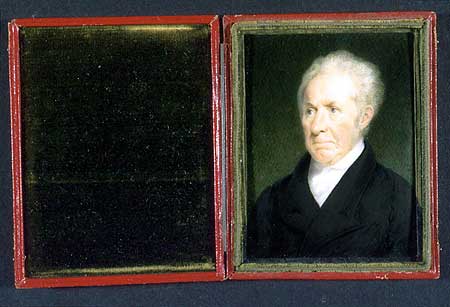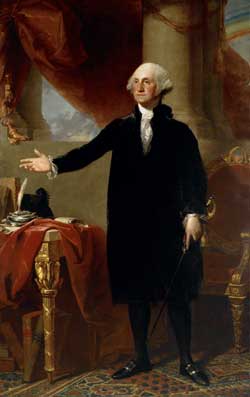Gilbert Stuart, Artist and Entertainer

This blogpost originally appeared May 13, 2008.
The impact of Gilbert Stuart’s (1755–1828) work on American portraiture is, of course, significant. And although he is most well known for his portraits of the Founding Fathers, his character was cut of an entirely different fabric. Gilbert Stuart is shown above, circa 1825, in a portrait by Sarah Goodridge from the National Portrait Gallery's collections.
Ellen Miles, curator of paintings and sculpture at NPG says of the artist, “Everything about Stuart is interesting! He spent the (Revolutionary) war years in England, and was married to an Englishwoman. Two of their children became artists. He painted the portraits directly on canvas, as did his English contemporaries, so there are no preparatory portrait drawings by him. He returned to America when he was thirty-eight specifically to paint portraits of George Washington.”
Stuart did not confine his time solely to his artistic industry, however; he liked to entertain. In his autobiography, Irish Varieties (1836), painter J. D. Herbert tells of Stuart’s legendary dinners when he lived near Dublin, Ireland in 1787-93:
He had a splendid house, and lived expensively. Amongst other servants, he kept a French cook. He began giving dinners, and invited forty-two persons to dine with him. Those were men of talent in some professional line—painters, poets, musicians, droll fellows, actors, and authors. After dinner he said to his friends, “I can’t have you all every day, but I will have seven of you to dine with me each day in the week; and I have contrived it so that the party shall vary without further trouble. I have put up seven cloak pins in my hall, so as the first seven that come may hang up their cloaks and hats; the eighth man, seeing these full, will go away, and probably attend earlier on the next day. Then it would not be likely that any one of the party of one day would come on the next, nor until the time for the forty-two should be expended; and Sunday should be excepted.” This compact was understood, and without trouble naming or writing, (he) had a different company every day, and no jealousies at a preference given to anyone.
Stuart’s extravagances took their toll on his income. In her book The Genius of Gilbert Stuart, NPG senior fellow Dr. Dorinda Evans states that, “He seemed to enjoy occupying a central position in what he deemed a ridiculous situation... He relished the tale of his finally submitting in 1789 to imprisonment for debt in Dublin’s Marshalsea Prison, where, to his glee, he received a constant succession of prominent and serious citizens who wished to have their portraits painted.”

Perhaps another irony Stuart would appreciate is the fact that although he struggled with debt, it is his image of George Washington that graces our dollar bill.
The centerpiece of NPG’s “America’s Presidents” gallery is Stuart’s “Lansdowne” image of George Washington (above), and that portrait’s origin is as paradoxical as its artist. “It was painted for an Englishman who was sympathetic to the goals of the American Revolution,” states Miles.